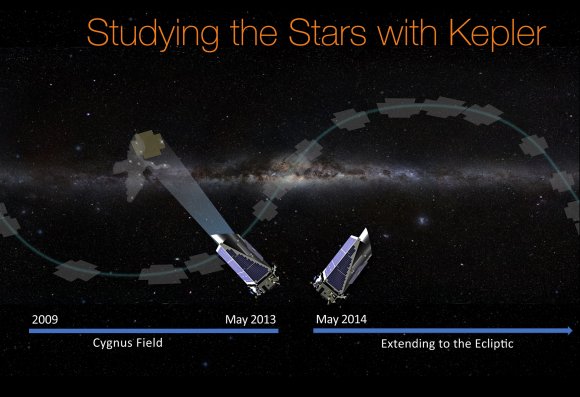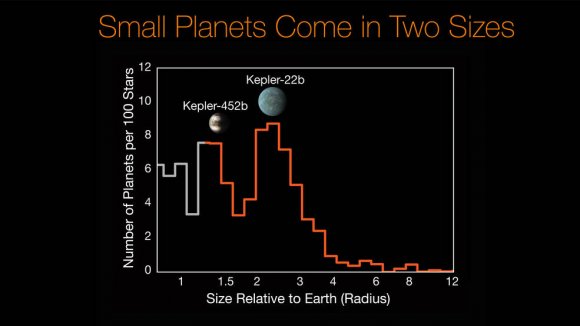The Kepler space telescope is surely the gift that keeps on giving. After being deployed in 2009, it went on to detect a total of 2,335 confirmed exoplanets and 582 multi-planet systems. Even after two of its reaction wheels failed, it carried on with its K2 mission, which has discovered an additional 520 candidates, 148 of which have been confirmed. And with yet another extension, which will last beyond 2018, it shows no signs of stopping!
In the most recent catalog to be released by the Kepler mission, an additional 219 new planet candidates have been added to its database. More significantly, 10 of these planets were found to be terrestrial (i.e. rocky), of comparable in size to Earth and orbited within their star’s habitable zone – the distance where surface temperatures would be warm enough to support liquid water.
These findings were presented at a news conference on Monday, June 19th, at NASA’s Ames Research Center. Of all the catalogs of Kepler candidates that have been released to date, this one is the most comprehensive and detailed. The eighth in a series of Kepler exoplanet catalogs, this one is based on data that was obtained from the first four years of the mission and is the final catalog that covers the spacecraft’s observations of the Cygnus constellation.
Since 2014, Kepler has ceased looking at a set starfield in the Cygnus constellation and has been collecting data on its second mission – observing fields on the plane of the ecliptic of the Milky Way Galaxy. With the release of this catalog, there are now 4,034 planet candidates that have been identified by Kepler – of which 2,335 have been verified.
An important aspect of this catalog were the methods that were used for producing it, which were the most sophisticated to date. As with all planets detected by Kepler, the latest finds were all made using the transit method. This consists of monitoring stars for occasional dips in brightness, which is used to confirm the presence of planets transiting between the star and the observer.
To ensure that the detections in this latest catalog were real, the team relied on two approaches to eliminate false positives. This consisted of introducing simulated transits into the dataset to make sure the dips that Kepler detected were consistent with planets. Then, they added false signals to see how often the analysis mistook these for planet transits. From this, they were able to tell which planets were overcounted and which were undercounted.
This led to another exciting find, which was the indication that for all of the smaller exoplanets discovered by Kepler, most fell within one of two distinct groupings. Essentially, half the planets that we know of in the galaxy are either rocky in nature and larger than Earth (i.e. Super-Earth’s), or are gas giants that are comparable in size to Neptune (i.e. smaller gas giants).
This conclusion was reached by a team of researchers who used the W.M. Keck Observatory to measure the sizes of 1,300 stars in the Kepler field of view. From this, they were able to determine the radii of 2,000 Kepler planets with extreme precision, and found that there was a clear division between rocky, Earth-sized planets and gaseous planets smaller than Neptune – with few in between.
As Benjamin Fulton, a doctoral candidate at the University of Hawaii in Manoa and the lead author of this study, explained:
“We like to think of this study as classifying planets in the same way that biologists identify new species of animals. Finding two distinct groups of exoplanets is like discovering mammals and lizards make up distinct branches of a family tree.”These results are sure to have drastic implications when it comes to knowing the frequency of different types of planets in our galaxy, as well as the study of planet formation. For instance, they noted that most rocky planets discovered by Kepler are up to 75% larger than Earth. And for reasons that are not yet clear, about half of them take on hydrogen and helium, which swells their size to the point that they become almost Neptune-sized.
Histogram shows the number of planets per 100 stars as a function of planet size relative to Earth. Credits: NASA/Ames Research Center/CalTech/University of Hawaii/B.J. Fulton
“The Kepler data set is unique, as it is the only one containing a population of these near Earth-analogs – planets with roughly the same size and orbit as Earth. Understanding their frequency in the galaxy will help inform the design of future NASA missions to directly image another Earth.”From this information, scientists will be able to know with a greater degree of certainty just how many “Earth-like” planets exist within our galaxy. The most recent estimates place the number of planets in the Milky Way at about 100 billion. And based on this data, it would seem that many of these are similar in composition to Earth, albeit larger.
Combined with a statistical models of how many of these can be found within a circumstellar habitable zone, we should have a better idea of just how many potentially-life-bearing worlds are out there. If nothing else, this should simplify some of the math in the Drake Equation!
In the meantime, the Kepler space telescope will continue to make observations of nearby star systems in order to learn more about their exoplanets. This includes the TRAPPIST-1 system and its seven Earth-sized, rocky planets. Its a safe bet that before it is finally retired after 2018, it will have some more surprises in store for us!
Further Reading: NASA, NASA Kepler and K2
The post NASA Announces 10, That’s Right 10! New Planets in Their Star’s Habitable Zone appeared first on Universe Today.


No comments:
Post a Comment